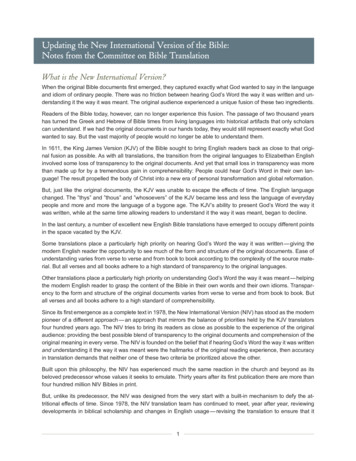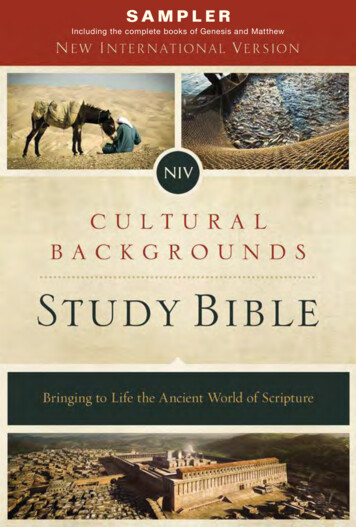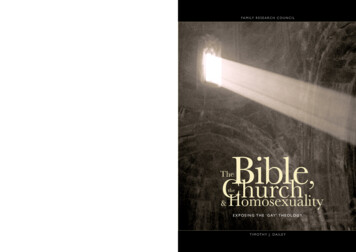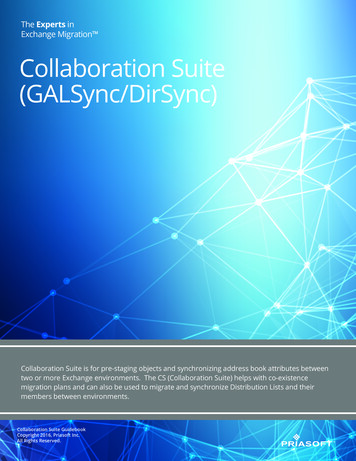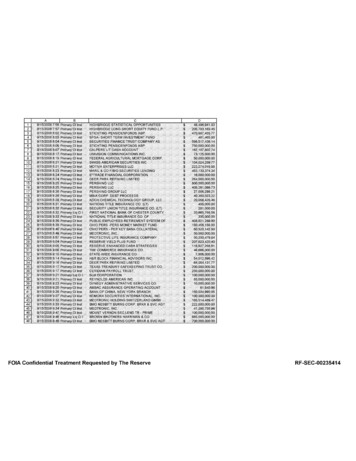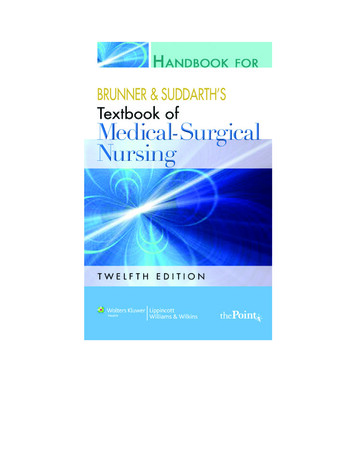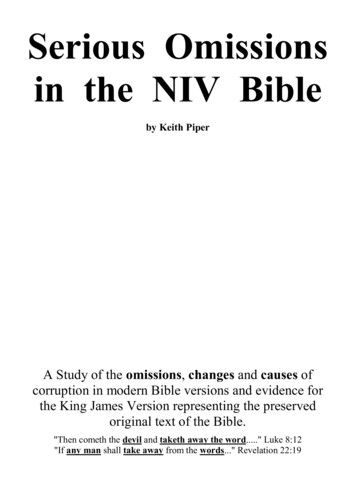
Transcription
Serious Omissionsin the NIV Bibleby Keith PiperA Study of the omissions, changes and causes ofcorruption in modern Bible versions and evidence forthe King James Version representing the preservedoriginal text of the Bible."Then cometh the devil and taketh away the word." Luke 8:12"If any man shall take away from the words." Revelation 22:19
Table of Contents1.Serious Omissions in the NIV Bible. 1a) 5 Key Changes. 1b) NIV Downgrades Christ in 17 Ways . 4c) NIV Changes Salvation Verses in 10 Ways . 11d) NIV Diminishes Godliness in 17 Ways . 13e) NIV Changes which support Roman Catholic Dogma in 13 ways . 212. Historical Background . 213. Public Acceptance of the Corrupt Westcott and Hort Greek Text . 254. Consider these False Doctrines held by Westcott and Hort and Ask Yourself . 285. Heresy, Deceit, False Methodology and Nonsense in the Revision Committee . 326. Why did 6 Modern Version Editors Lose their Voices? . 367. Bad Effects of Modern Versions. 388. Seven Tests to Determine the True New Testament Greek Text . 399. Errors of the New King James Version . 4110. History of the New Testament Text. 4711. The last 12 Verses of Mark (16:9-20). 5312. Manuscript Materials Available. 5513. 238 Other Omissions in the NIV . 6614. What’s Wrong with ‘Eclectism’?. 7715. Hort’s Three False Reasons for Rejecting the Majority Text . 7816. The Earliest Manuscripts Contain Mostly Majority Text Readings. 8017. History of the King James Bible. 9018. Corruption in Codex Vaticanus (B) and Codex Sinaiticus (Aleph) . 9219. 60 NASV Omissions that the NIV Corrected to Agree with the KJV . 9520. The NIV Omits the LORD (39 times), JESUS (87 times), CHRIST (52 times). 9721. Questions to Ask Modern Bible Version Users . 10022. Errors of ‘Good News for Modern Man’ . 10223. Errors of the ‘Living Bible’ . 10624. 101 Archaic Words in the NIV . 10725. The NIV Attacks Jesus Christ in 30 Ways. 10826. Has the KJV been Revised Four Times? . 11027. Why Reject the United Bible Societies Greek New Testament . 11128. Evidence for Including the 16 Verses that the NIV Omits. . 11629. Summary and Conclusion . 11930. Dictionary of Unfamiliar Words in the KJV and Modern Versions . 121Verse Index . 133Copyright Keith Piper: 1st Edition May 1998; 2nd Edition February 2005.Other books by the same author:"Answers", a complete 1250 page handbook of 271 chapters on a wide range of practical subjectsto assist in soul-winning, discipleship, Bible teaching, church planting and refuting false doctrinesand false religions. Essential for every Christian. "Bible College Assignment Questions" (100p).Further copies may be obtained by contacting the author (Keith Piper) at:PO Box 188 Cherrybrook, NSW, 2126, Australia. Email: piperkeith@yahoo.com.auTelephone: 02-98754321 (in Australia). 61-2-98754321 (International). Fax: 02-9980-7830.137
1. SERIOUS OMISSIONS IN THENIV BIBLEIntroduction.Is God able to preserve His word to today?Did Christians from 350 AD to 1881 AD not have the correct Word of God, until theWestcott and Hort heretics “saved the day” for God, the Bible, Christians and the world?Is God in control of Bible preservation or not? If God can give us His infallible word inthe first century, is He unable to preserve it for Christians up to the 20th century?By the year 500 AD, the NT manuscript text chosen by the wealthy upper classes whocould afford to ignore the expense, was without exception of the Byzantine/KJV text type.Why?These parchments being stained with purple and written in silver or gold, tell us that thesewealthy, upper class Christians, who had greater knowledge of, and access to the true NTtext, clearly preferred the Byzantine KJV text over the Alexandrian papyri. They wouldhave known of the Alexandrian texts as corrupt, and hence rejected them. This is a strongargument for KJV readings. See “The Text of the NT” by Kurt Aland, p.77.1. “Ye shall not ADD unto the WORD which I command you, neither shall yeDIMINISH ought from it, ” Deuteronomy 4:2.2. “Satan cometh immediately and TAKETH AWAY THE WORD ” Mark 4:15.3. Jesus said: “Till heaven and earth pass, one jot or one tittle shall in no wise pass fromthe law, till all be fulfilled.” Matthew 5:18.4. “If any man TAKE AWAY from the WORDS of the book of this prophecy, God shalltake away his part out of the book of life, and out of the holy city.” Revelation 22:19.I. KEY CHANGES TO DISCUSS INITIALLY.1. The NIV in Luke 11:2-4 omits key parts of the LORD’S PRAYER.The devil would not want us to pray these omitted words.Matthew 6:9-13 in both KJV and NIV includes these omitted words in the Lord’s Prayer.NIV, NASB, et alOMIT Father OMIT ,hallowed be your name.Your kingdom come,OMIT .Give us each day our daily bread.Forgive us our sinsfor we also forgive everyonewho sins against us.And lead us not into temptationOMIT .Luke 11:2-4KJVOur Father which art in heavenhallowed be thy name.Thy kingdom come.Thy will be done,as in heaven so in earth.Give us day by day our daily breadAnd forgive us our sins;for we also forgive everyonethat is indebted to us.And lead us not into temptation;but deliver us from evil.1
a) Which “FATHER”? New Agers pray to another father which is not in heaven, but isthe “god of this world”. “Ye are of your father the devil”. John 8:44.Satan likes being called “Father” because he wants to be like the Most High.b) “OUR” must be removed because it opposes the New Age idea of the “universalfatherhood of God”. They think God is the Father of all people. They object to God beingthe Father only of Christians (John 1:12).c) “WHICH ART IN HEAVEN” identifies the Father to be worshipped as God inheaven and not the devil.d) “THY WILL BE DONE, AS IN HEAVEN, SO IN EARTH”.The devil does not want us to pray that God’s will be done on earth as it is in heaven.Hence it is omitted.e) “DELIVER US FROM EVIL”. The devil doesn’t want us to pray for God to deliverus from evil but rather he wants evil to come to us. Evil is too black and white. The devildoesn’t want us to think about good and evil, heaven and hell. Hence he removes themfrom the Luke 11:2-4 Lord’s Prayer in modern versions.2. The NIV, in Isaiah 14:12, BLASPHEMES CHRIST by putting Him in the place ofLucifer the devil?NIVHow you have fallen from heaven,O MORNING STAR,Isaiah 14:12KJVHow art thou fallen from heaven,O Lucifer, son of the morning!how art thou cut down to the ground,which did weaken the nations. v.12Thou hast said in thine heart.I will be like the most High. v.14But you are brought down to the Yet thou shalt be brought down toGRAVEhell.(v15)“Lucifer” (KJV) becomes “Morning Star” (NIV).But JESUS Christ calls Himself “the bright and morning star” in Revelation 22:16.So the NIV by inserting “morning star” in Isaiah 14:12,a) Removes all mention of Lucifer as the devil’s personal name from Scripture.b) Blasphemes Christ by accusing Him as the One who weakens the nations. v.12c) Denies Christ’s deity by stating that Christ wanted to be like the most High. v.14d) Blasphemes Christ by predicting that He will be brought down to hell. v.15e) They change “hell” to “grave”, thus removing the warning against hell. v.15f) Blasphemes Christ by saying that He has fallen from heaven. v.12.Note: “MORNING STAR” (NIV) is a wrong translation because:a) “STAR” (3556 Kokab) appears nowhere in Isaiah 14:12.b) “MORNING” (7837 shachar) appears only once in v.12, (son of the morning), nottwice as NIV claims.c) “LUCIFER” (1966 heylel) comes from the root word “to shine” (1984 halal), andmeans “shining one” or “bright one”.d) The Septuagint translates it as:“How has Lucifer, that rose in the morning, fallen from heaven”.2
3. NIV in Micah 5:2 says Christ has an ORIGIN, wrongly making Him a CREATEDbeing.NIVMicah 5:2KJVwhose origins are from of old,whose goings forth have been from offrom ancient times.old, from everlasting.Note: This is sickening heresy for NIV to say that Christ had an origin. It makes Christ acreature, and not God. “Goings forth” in KJV means that Christ always existed."Of old" (qedmah in Hebrew, 6924) means eternal, everlasting and is used of Jehovah inHabakkuk 1:12, "Art thou not from everlasting, O Jehovah my God, mine Holy One?""from everlasting" (olam in Hebrew, 5769) means eternity, always, time out of mind.4. NIV omits “FORNICATION” from the sins listed with sodomy in Romans 1:29.NIVRomans 1:29KJVThey have become filled withBeing filled with allevery kind of wickedness, unrighteousnessOMIT fornication,Evil wickedness,Greed covetousness,Depravity maliciousness,They are full of envy full of envy,Murder murder,Strife debate,Deceit deceit,Malice malignity,They are gossips whisperers.Note: The word “fornication” has been completely removed from NIV and replacedwith “sexual immorality” which allows the individual to define it.5. NIV comes from a WRONG SPIRIT because it fails the test of not being able toconfess that “Jesus Christ is come in the flesh.” I John 4:3.NIVI John 4:3KJVBut every spirit that does not acknowledge And every spirit that confesseth notJesusOMITthat “Jesus Christ is come in the flesh"is not from God.is not of God,This is the spirit of the antichrist.and this is that spirit of antichrist.This is an amazing test for the NIV to fail, because it proves that the NIV comes from aspirit that is not from God. The NIV cannot confess here that “Jesus Christ is come inthe flesh”. John says that NIV has the spirit of antichrist, as seen by its many omissionsof Christ’s names, titles and attributes.To merely confess “Jesus”, is not passing this test, because Paul warns us of peoplecoming and preaching “another Jesus”. Which Jesus are they confessing?They may be confessing a different Jesus - “If he that cometh preacheth another Jesus,whom we have not preached.” (II Corinthians 11:4).3
II. THE NIV DOWNGRADES JESUS CHRIST.1. The NIV changes Matthew 5:22 to teach that CHRIST SINNED.NIVMatthew 5:22KJVThat whosoever is angry with his brotherAnyone who is angry with his brotherOMITwithout a causeshall be in danger of the judgment.will be subject to judgment.Because Jesus showed righteous anger in Mark 3:5, the NIV makes Christ a sinner subjectto judgment. If Christ is a sinner, He cannot be our Saviour.Bible critics love the NIV here because they claim Christ to be a sinner due to His angerin overthrowing the money changers’ tables (John 2:15), and how He looked on thereligious leaders with anger at them rebuking Him for healing on the Sabbath in Mark 3:5.This is another contradiction in modern versions.The KJV is consistent and without contradictions.2. NIV denies Jesus’ VIRGIN BIRTH in Luke 2:33 by stating that Joseph was Jesus’father. This denies that God was His Father. If Joseph was Jesus’s father, then Jesusinherited a sin nature and He would be unable to save us. What a worry if the NIV is true!NIVLuke 2:33KJVThe child’s father and mother.Joseph and his mother marvelled.3. The NIV denies Christ WORSHIP in 6 out of 12 passages.NIV (4352)a man with leprosy came and knelt.Matt. 8:2a ruler came and knelt before him9:18KJV (4352)there came a leper and worshippedhim,there came a certain ruler andworshipped him.Then came she and worshipped himThe servant fell down andworshipped him.the mother of Zebedee’s childrenworshipping him,he ran and worshipped him.Woman came and knelt before him. 15:25Servant fell on his knees before18:26OMIT him. (NKJV omits worshipped)Mother of Zebedee’s sons kneeling 20:20down. (NKJV omits worship)he ran and fell on his kneesMark 5:6Jesus Christ is God because He is worshipped.“Thou shalt worship the Lord thy God, and Him only shalt thou serve.” Matthew 4:10.“Let all the angels of God worship him.” Hebrews 1:6.12 times in the New Testament, Jesus is worshipped (Greek: proskuneo 4352), yet theNIV and NASV change worship 4352 (KJV) to kneel (NIV) or bow down (NASV).Question: What is the difference?Kneel or bow down is a position of the body, whereas worship is an attitude of the spirit.Worship in Greek is “proskuneo” 4352. Bow is “kampto, klino, or tithemi”, and is usedonly in a mocking manner by Christ’s executioners. For example:“and bowing (tithentes) their knees worshipped (prosekunoun) him.” Mark 15:19.4
The other 6 times that the NIV translates “proskuneo” as “worship are: Matthew 2:11;14:33; 28:9,17; Luke 24:52; and John 9:38. Why is the NIV inconsistent?The NIV therefore detracts from Christ’s Deity.4. The NIV in Ephesians 3:9 removes Christ from being CREATOR.NIVEphesians 3:9KJVGod, who created all thingsGod, who created all thingsOMITby Jesus Christ.5. The NIV lowers Christ from being God’s SON and CHILD, to merely God’sSERVANT. All believers are God’s servants.NIVKJVhas glorified his servant Jesus.Acts 3:13hath glorified his Son Jesusraised up his servant OMITActs 3:26raised up his Son Jesus.holy servant JesusActs 4:27holy child Jesus.holy servant JesusActs 4:30holy child Jesus.6. NIV removes Christ from being our SOURCE OF STRENGTH in Philippians 4:13.New Agers see Philippians 4:13 as a “fill in the blank” deity.NIVPhilippians 4:13KJVI can do everything through himI can do all things through Christwho gives me strength.which strengtheneth me.7. The NIV denies that we have been made an HEIR OF GOD through Christ.NIVGalatians 4:7KJVSince you are a son, God hasIf a son, then an heir of Godmade you also an heir OMITthrough Christ.8. The NIV denies that Christ came to SAVE LOST SINNERS in Matthew 18:11.NIVMatthew 18:11KJVOMITFor the Son of man is come to savethat which was lost.Why would Westcott and Hort reject Matthew 18:11? Because:i) they elevated Sinaiticus and Vaticanus to be the authority over all other manuscripts.ii) they add “interpolated either from Luke 19:10 or from an independent source, writtenor oral” with no historical or manuscript support. Some gullible people believe them.The critical text footnote lists 44 manuscripts with it and 20 without.9. The NIV changes John 16:16 to deny CHRIST’S ASCENSIONNIVJohn 16:16KJVIn a little while you will see meA little while and ye shall not see me:no more, and then after a littleand again, a little while, and ye shallwhile you will see me OMITsee me, because I go to the FatherNote: This is in all uncials, all cursives, all versions, Nonnas(3rd Century), Chrysostom, Cyril (4th Century)5
10. The NIV denies Jesus Christ’s DEITY in I Corinthians 15:47.NIVI Corinthians 15:47KJVthe second man is OMIT from heaven.the second man is THE LORD from heaven.This verse is a very clear proof that Jesus Christ is God.Who is “the Lord from heaven”? Only God is the Lord from heaven. Jesus Christ is God.The NIV follows the Westcott and Hort, and Vaticanus lie and deletes it.The KJV reading, “the Lord” is supported by the following manuscript evidence:Uncials: Codex Alexandrinus (400 AD), K, P,Minuscules: 1881,1962,1984,1985,2127,2492,2495.All the Lectionaries quoting I Corinthians 15:47.Ancient versions: Syriac Peshitta (170 AD), Syriac Palestinian (420 AD), Gothic version(341 AD), Syriac Harklensis (616 AD), Armenian (400 AD).Early writers: Origen, Basil, Chrysostom, Maximinus, Cyril, Euthalius, Theodoret,Cosmas, John of Damascus.Also, doctrinally, no man has ever originated from heaven, because God dwells in lightwhich no man can approach unto (I Timothy 6:16), and all men originate from earth. EvenChrist’s humanity originated from earth. However, Christ’s deity came from heaven.11. NIV denies Jesus’ OMNIPRESENCE and hence denies Jesus’ DEITY in John 3:13.NIVJohn 3:13KJVAnd no man hath ascended up to heavenNo one has ever gone into heavenbut he that came down from heaven,except the one who came from heaveneven the Son of man which is in heaven.the Son of manOMIT .Q1: How can Jesus talk to Nicodemus at Jerusalem and be in heaven at the same time?Answer: Only God can be in 2 places at once, so John 3:13 shows that Jesus is God.Hence the NIV coming from corrupt Vaticanus and Westcott and Hort, omits this proofpassage of Jesus Christ’s Deity.Q2: Why does the footnote not tell us that the clause omitted “which is in heaven”, iscontained in all manuscripts in the world, except 5 of bad character?It is found in all the Latin versions and all the Syriac versions, the Coptic, Ethiopic,Georgian and Armenian versions (10 versions), and by 38 church fathers.995 manuscripts have it, with 5 omitting it (Burgon).The NIV, by omitting this phrase, and not informing the reader of the great mass ofmanuscript evidence for its inclusion, serves to perplex the weak, unsettle the doubting,and to mislead the ill-informed. We retain this phrase because:i) It is quoted by manuscripts from every area of ancient Christendom,ii) It is more ancient (by 200 years) than the manuscript evidence for omitting it.iii) It is quoted by more manuscripts, in the proportion of 99 for to 1 against it.iv) It is quoted by highly respected writers. Origin, Didymus, Epiphanius, Cyril,Athanasius, Ambrose, Hippolytus 200 AD (vol. 5, p.225), Novatian 220 AD (vol 5.p.622) and Jerome, all quote and recognise the words in dispute.Some early writers (Origen, and Jerome) sometimes end the verse at “Son of man”because they are emphasizing the first part of the verse. “The Revision Revised,” J. Burgon, p.1336
12. The NIV denies Jesus Christ’s DEITY in I Timothy 3:16NIVI Timothy 3:16KJVHE appeared in a body.GOD was manifest in the fleshThis change from “God” (KJV) to “He” (NIV) sabotages the verse most strongly provingthat Jesus Christ is 100% God. (Westminster Confession, Section 8, par.2).John Burgon in “The Revision Revised”, p.485-497, shows that “God” (theos) is thecorrect reading because:1) “ Theos” (God) is the reading in 300 Greek manuscripts containing I Timothy 3:16.Only 5 late manuscripts (9th, 12th, 13th Century) omit “God”. The Uncials, Aleph, Aand C have been altered so that either “God” or “who” can be deduced. (see point 5).2) All the Lectionaries from the 4th Century onwards read “Theos” (God).3) Early Church writers quote “Theos” meaning “God” as follows:First Century: Ignatius (90 AD) in 3 places, Barnabus (90 AD).Second Century: Hippolytus (190 AD) in 2 places in the second century.Third Century: Thaumaturgus (270 AD), Dionysius of Alexandria (264 AD), thework “Constitutiones Apostolicae” (250 AD).Fourth Century: Didymus of Alexandria (309 AD), Basil the Great (355 AD),Gregory of Nazianzus (355 AD) in 2 places, Gregory of Nyssa (370 AD), Diodorus(370), Chrysostom (380 AD) in 3 places.Fifth Century: Codex Alexandrinus, (420 AD) Cyril of Alexandria (410 AD) in 2places, Theodoret of Syria (420 AD) in 4 places, Athanasius’ appendix (430 AD),Euthalius (458 AD), Macedonius II (496 AD).Sixth Century: Severus of Antioch (512 AD), etc.4) Ancient versions showing “God” are:The Latin version (195 AD), Syriac Peshito version (170 AD), Harklean version(616 AD), Gothic version (341 AD), Ethiopic version (450 AD), Georgian version(550 AD), Slavonic Version (840 AD).5) Greek grammar rule forbids “os” meaning “who” because:“mystery” being a neuter noun (in Greek), cannot be followed by masculinepronoun (os) - “who”. (p.426 Burgon).Also, the few (6) manuscripts which have “who” (os) in the place of “God”, do nothave a complete sentence without the subject “God”.“Who was manifest in the flesh” makes no sense.Also, logically, there would be no mystery in a man being manifested in the flesh.The NIV, to avoid having a clause with no subject, arbitrarily drops the word “who”and invents a new word “He”, which is not found in any Greek manuscript.6) The uncials Aleph, A & C have been altered so that either “God” or “who” can bededuced. Although the middle stroke that distinguishes “God” from “who” has beenretouched, the fine original stroke is discernible at each end of the fuller stroke of thecorrector. (os) is the abbreviation of God in the manuscripts.See Wetstein in 1716, quoted in “True or False”, D.O. Fuller, p.33.7
13. The NIV denies the TRINITY and DEITY of CHRIST in I John 5:7,8.This is called ‘The Johannine Comma’.NIVI John 5:7,8KJVFor there are three that (oi masc) bear recordFor there are three that testifyOMITin heaven, the Father, the Word, andOMITthe Holy Ghost: and these three are one.OMITAnd there are three that bear recordOMITin earth,the Spirit, and the water, and the bloodthe Spirit, the water, and the blood;and these (oi masc) three agree in one”.and the three are in agreement.I John 5:7,8 is omitted by all modern versions. It is called the “famous Trinitarian Prooftext”. Modernists claim that this passage ought not to be in the Bible, because it is not inmost Greek manuscripts. Only 6 Greek manuscripts before the 7th Century omit v.7,8.(14 manuscripts before the 9th Century).Background: Erasmus omitted it from his first edition of the printed Greek N.T. (1516),because it occurred in the Latin Vulgate and not in any Greek manuscript. To quieten theoutcry that followed, he agreed to restore it if one Greek manuscript could be foundcontaining it. Two Greek manuscripts, Codex 61 and 629 were presented, so Erasmusincluded it in his 1522 edition. Since these manuscripts are late (15th and 16th centuries)some think the readings are corrupt. What do we answer?What early manuscript evidence exists for I John 5:7,8?i) Early church writers:- Cyprian 200-258 AD. “The Lord says, ‘I and the Father are one;’ and again it iswritten of the Father, and of the Son, and of the Holy Spirit, 'And these three areone’.” If Cyprian quotes I John 5:7 from his Bible in 200-258 AD, it must be a validreading. His Bible was copied from an older manuscript containing this verse.Cyprian lived only 100 years after John wrote the book of I John.Cyprian would have had access to the original manuscript to check.- Priscillian 350 AD, a Spanish bishop quotes I John 5:7,8.- Idacius Clarus 360 AD, who opposed Priscillian quotes it.- Varimadum 380 AD.- Cassiodorus 485 AD.- Cassian 435 AD.- Victor Vita 489 AD.- Jerome 450 AD.- Fulgentius 533 AD.- Ps. Vigilius 484 AD.- Ansbert 660 AD.ii) Early Bible Versions: Old Syriac 170 AD.Old Latin 200 AD, in North Africa and Italy.Italic 4th and 5th century. – Italic - Monacensis 7th century.Italic - Speculum 9th century.Latin Vulgate 4th, 5th century.iii) Greek minuscule manuscripts:(UBS Greek NT, p.824; History of Debate over I John 5:7,8,p268).- 221 in the 10th century.(variant).- 636 in the 15th century. (margin).- 88 in the 12th century.(margin).- 61 in the 16th century.(Codex Montfortianus)- 629 in the 14th century.(Ottobanianus) - 918 in the 16th century. (an Escorial ms).- 429 in the 14th century (margin).- 2318 (a Bucharest manuscript).8
iv) Early writings: Liber Apologeticus 350 AD. Council of Carthage 415 AD.v) Greek grammar rules demand its presence. NIV has mismatched genders in v. 7,8.Question 1: If the NIV is right in omitting the Johannine comma, then why do we have amasculine Greek article (oi) in v.7 (oi marturountes that bear record in heaven) wronglyagreeing with three neuter nouns (Spirit, water and blood) in v.8?Spirit, water and blood are all neuter Greek nouns with neuter Greek articles, whichwould dictate a neuter Greek article in v.7, (if the Johannine comma was never in theoriginal), but we have masculine articles (oi) in v.7,8. Why?Question 2: What is it that causes the masculine Greek article (oi) in v.7 and (oi) in v.8?Answer: It is the two masculine nouns (Father and Word) of the Johannine comma inv.7. These control the gender of the article connected with them to be a masculine article(oi) which is what we have.Hence the problem is solved if the Johannine comma is part of the Greek text.Therefore, the NIV and NWT have wrong Greek grammar by omitting the Johanninecomma, as seen by them having a masculine article in verse 7 wrongly agreeing withthree neuter nouns (Spirit, water and blood) in verse 8.Question 3: Why would the Johannine Comma be absent from some Greek manuscripts,but present in the Latin manuscripts?Firstly, because of a similar ending in v.7 and v.8, a scribe may have been distracted inv.7, but when resuming his copying, his eye fell on v.8 from where he continued copying,thus accidentally omitting the Johannine Comma.Copies of this would have multiplied the mistake.Secondly, between 220-270 AD, the heresy that Greek Christians were fighting was notArianism (denying Christ’s deity) as this had not yet arisen, but Sabellianism (named afterSabellius) which taught that the Father, Son and Holy Spirit were identical, and that Godthe Father died on the cross when Christ died on the cross. The statement in theJohannine comma that “these three are one” seemed to support the Sabellian heresy thatthe Father, Son and Holy Spirit are identical. If, during the course of this controversy,manuscripts were discovered which had accidentally lost the Johannine Comma asdescribed above, it is easy to see how the orthodox party would consider these mutilatedmanuscripts to be the true text.In the Greek speaking east, where the struggle against Sabellianism was most intense, theJohannine comma came to be unanimously rejected.However, in the Latin manuscripts of Africa and Spain, where the influence ofSabellianism was not so great, the Johannine Comma was retained. This explains whythe Johannine comma is strongly represented in the Latin manuscripts, and why weshould retain it today. Source: “KJV defended”. E.F. Hills, p.204-208.14. The NIV denies Jesus Christ’s RESURRECTION BODY in Ephesians 5:30.NIVEphesians 5:30KJVFor we are members of his bodyFor we are members of his body,OMITof his flesh, and of his bones.The NIV caters to the New Age movement which allows for an afterlife of the soul orspirit, but does not believe in a bodily resurrection.9
NIVActs 2:30KJVBut he was a prophet, andTherefore being a prophet, andknew that God had promised himknowing that God had sworn withon oath that he would place onean oath to him, that of the fruitof his descendantsof his loins, according to the fleshOMIThe would raise up Christ to siton his throne.on his throne.This omission by NIV removes the fleshly, bodily resurrection of Christ.15. Each of these 4 NIV alterations detracts from Christ’s RIGHT TO JUDGE.NIVWe will all stand beforeGod’s judgment seat.(According to NIV, God is thejudge, not Christ).That the day of the LordWe should not test the LordTo seat one of his descendantsupon his throne.Romans 14:10II Thess. 2:2I Cor. 10:9Acts 2:30KJVWe shall all stand before thejudgment seat of Christ.that the day of Christ is at hand.Neither let us tempt Christ.He would raise up Christ to sit onhis throne.16. The NIV removes “LORD” 39 times, “CHRIST” 52 times, and “JESUS” 87 timesfrom the KJV New Testament. This is 178 removals of our Saviour’s name.It is very important to give Jesus Christ His rightful position as “Lord”.i) “God hath made that same Jesus whom ye have crucified both Lord and Christ.”Acts 2:36.ii) “That the name of our Lord Jesus Christ may be glorified.” II Thessalonians 1:4,12.iii) “If thou shalt confess with thy mouth the Lord Jesus.thou shalt be saved.” Rom 10:9“No man can say that Jesus is the Lord but by the Holy Ghost.” I Corinthians 12:3.iv) “Certain men crept in unawares.ungodly men.denying the only Lord God and ourLord Jesus Christ”. Jude 4.v) “There shall be false teachers among you.even denying the Lord.” II Peter 2:1.Lord used in conjunction with Jesus Christ proves His eternal Deity and pre-existence.“Lord” connects Jesus Christ of the New Testament, with “LORD” of the Old Testament.Jehovah, Jesus Christ and the Holy Spirit are alone given this title. II Corinthians 3:17.17. NIV doesn’t want Christ to be SET OVER the works of creation in Hebrews 2:7.NIVKJVThou madest him a little lowerYou have made him a little lowerthan the angels, thou crownedst himthan the angels, You crowned himwith glory and honour,with glory and honour,OMITand didst set him over the works of thy handsHaving a kingdom withou
Bible critics love the NIV here because they claim Christ to be a sinner due to His anger in overthrowing the money changers’ tables (John 2:15), and how He looked on the religious leaders with anger at them rebuking Him for healing on the Sabbath in Mark 3:5. This is a
